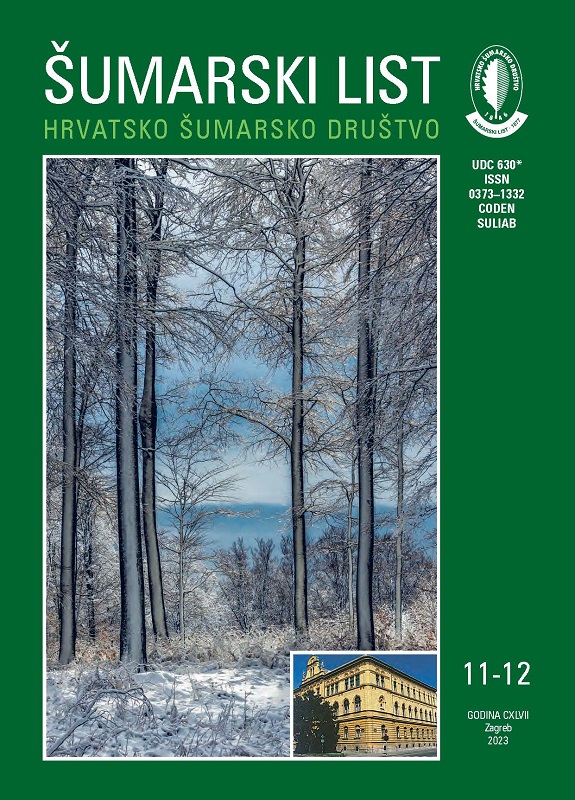
broj: 11-12/2023
pdf (9,99 MB) |
|
||||||||||||||
| RIJEČ UREDNIŠTVA | ||
| Uredništvo | ||
| At the end of 2023 pdf HR EN | 503 | |
| IZVORNI ZNANSTVENI ČLANCI | ||
| Damir Drvodelić, Milan Oršanić, Damir Ugarković, Mario Šango | UDK 630* 232.3 (001) https://doi.org/10.31298/sl.147.11-12.1 | |
| Comparison of vitality and laboratory germination of holm oak acorns (Quercus ilex L.) pdf HR EN | 505 | |
| Nera Bakšić, Darko Bakšić | UDK 630* 114 (001) https://doi.org/10.31298/sl.147.11-12.2 | |
| Forest floor fuel loads in holm oak (Quercus ilex L.) and pubescent oak (Quercus pubescens Willd.) forests pdf HR EN | 513 | |
| Mirzeta Memišević Hodžić, Sulejman Sinanović, Dalibor Ballian | UDK 630*164 (001) https://doi.org/10.31298/sl.147.11-12.3 | |
| The relationship of growth characteristics and wood quality on the experimental plot of larch pdf HR EN | 525 | |
| Biljana M. Nikolić, Katarina Mladenović, Ljubinko Rakonjac, Slobodan Milanović, Marija M. Marković, Srdjan Bojović, Nevena Čule | UDK 630*164+272 (001) https://doi.org/10.31298/sl.147.11-12.4 | |
| Influence of crown exposure on the morphological needle traits of nine conifers pdf HR EN | 535 | |
| PRETHODNO PRIOPĆENJE | ||
| Jovana Devetaković, Milutin Đilas, Ivona Kerkez Janković | UDK 630*164 https://doi.org/10.31298/sl.147.11-12.5 | |
| Stocktype impact on survival and growth of one-year old Quercus pubescens seedlings on the edge of Panonnian basin pdf HR EN | 547 | |
| Summary Querqus pubescens has relatively wide distribution in Europe, but dominated forests are quite common in South Europe, while they are confined to warm microclimatic conditions in central Europe. On the edge of the Panonnian basin Q. pubescens is mainly found on the edge of its native range, in isolated populations which have an important role in examining the adaptive potential, especially considering that the forest-steppe and sub-mediterranean climate is predicted to be the dominant climate in some regions of Central Europe in future. There are very limit knowledge about Q. pubescens forest establishment and restoration in continental climate today. This study provides information about stocktype effect on seedlings success after outplanting in very competitive conditions. Although bareroot seedlings were larger in the nursery, container seedlings had better survival and growth on the field. Generally, low survival rate for both stocktypes (mean survival 47.60 %; container seedlings 55.41%; bareroot seedlings 41.41%) can be assessed as consequence of uncompetitive seedlings and lack of vegetation control. Key words: stocktype; survival; growth; lack of vegetation control; restoration | ||
| STRUČNI ČLANCI | ||
| Saša Bogdan, Ida Katičić Bogdan, Martina Temunović | UDK 630* 232.3 https://doi.org/10.31298/sl.147.11-12.7 | |
| On the use of foreign forest reproductive material for the regeration of local stands of pedunculate oak from the stand points of a genetics pdf HR EN | 565 | |


